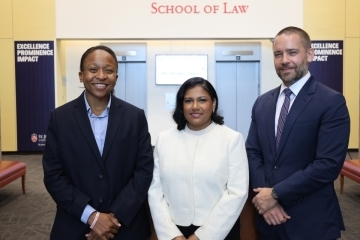Sitting across from the Assistant District Attorney prosecuting the case against their client, Ramona*, St. John’s Law Defense and Advocacy Clinic students Nathalie Amazan ’26 and Cassie Khan ’26 opened their PowerPoint presentation.
Slide after slide, they built a compelling defense. Cell site location information and call records showed that Ramona was in upstate New York at the time her 13-year-old niece claimed she had threatened her with a knife in Queens. There was also proof that Ramona was abused by her husband, tried to report the abuse multiple times, and had called 911 again just before her niece accused her of menacing.
Convinced by the Clinic students’ view of the evidence, the prosecutor dismissed the case in the interests of justice. It was a huge relief for Ramona, who avoided serious immigration, family court, and employment consequences and took a critical step toward ending her abusive relationship. It was also a pivotal moment for the students, who saw firsthand how criminal discovery reforms can empower effective advocacy.
For decades, New York’s discovery law allowed prosecutors to withhold critical evidence until just before trial. “It was a ‘Blindfold Law’ that created absurd outcomes,” says Professor Martin J. LaFalce, the Defense and Advocacy Clinic’s director. “Some defendants never knew the name of their accuser, much less the substance of evidence against them. It made it virtually impossible for defense attorneys to conduct meaningful investigations, make informed decisions about plea offers, track down exculpatory information, and develop strategies before trial.”
That changed with criminal discovery reforms instituted in 2020 that require prosecutors to turn over most evidence—including police reports, body camera footage, and witness statements—early in the process. “The law has transformed New York’s criminal system,” LaFalce notes. “It’s been rolled back several times, but core provisions remain intact. Our clients now receive evidence early enough in their cases that it can make a real difference in our investigations, decision making, and efforts to achieve reasonable outcomes.”
Reflecting on her teamwork with Amazan, Khan says: “Ramona’s case was about the discovery. It could have very well ended a different way if it weren’t for the 2020 reforms.” Examining the evidence, the students found that Ramona’s niece had given conflicting accounts of the alleged incident. They also viewed police body camera footage that raised their suspicion of a falsified complaint. Based on their investigation, they worked with Legal Aid to subpoena the cell site records and developed the defense strategy that ultimately vindicated Ramona.
It was a profound experience for Amazan. “Throughout, Cassie and I were Ramona’s primary point of contact,” she shares. “We regularly stayed in contact with her to answer any questions she had. We wrote a motion, did legal research, reviewed discovery, appeared in court, and even assisted her with the collateral consequences of her criminal case. I’ll bring that practical experience, self-confidence, and inspiration to my future work in the field, knowing that I have the capacity to be someone’s defense counsel and that, with a dedicated team, our advocacy can go a long way for those who get caught up in the system.”
Khan agrees that her Clinic experience will have a lasting impact. “Ramona reminded me of myself: a young brown woman, an immigrant,” she says. “What happened to her can happen to anyone, including me. At any point, you can have an interaction with our criminal system. I would want strong representation, and providing that for Ramona meant a lot to me. Most importantly, she got to tell her story, the evidence prevailed, and I was part of that process. I’m proud of what we accomplished—and grateful that we made a real difference in Ramona’s life.”
*Note: “Ramona” is a pseudonym used at the client’s request to protect her identity as a survivor of domestic violence.

